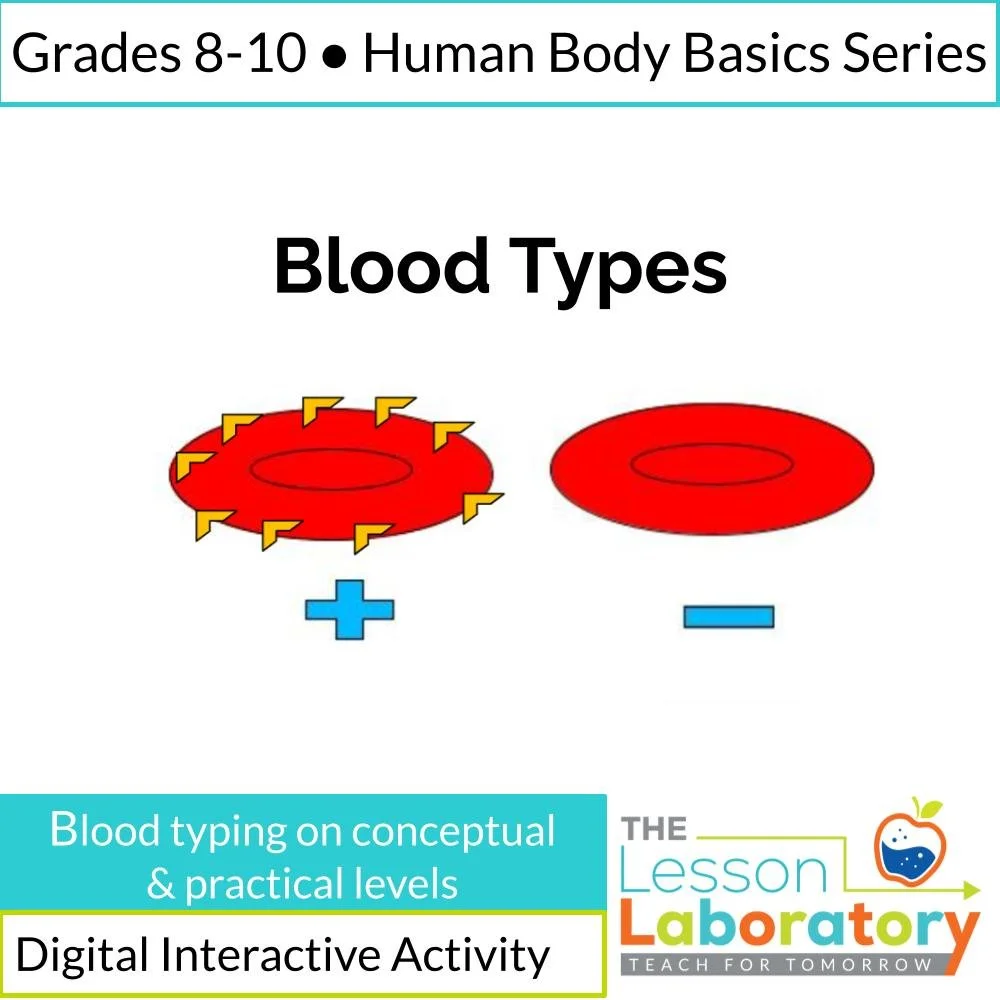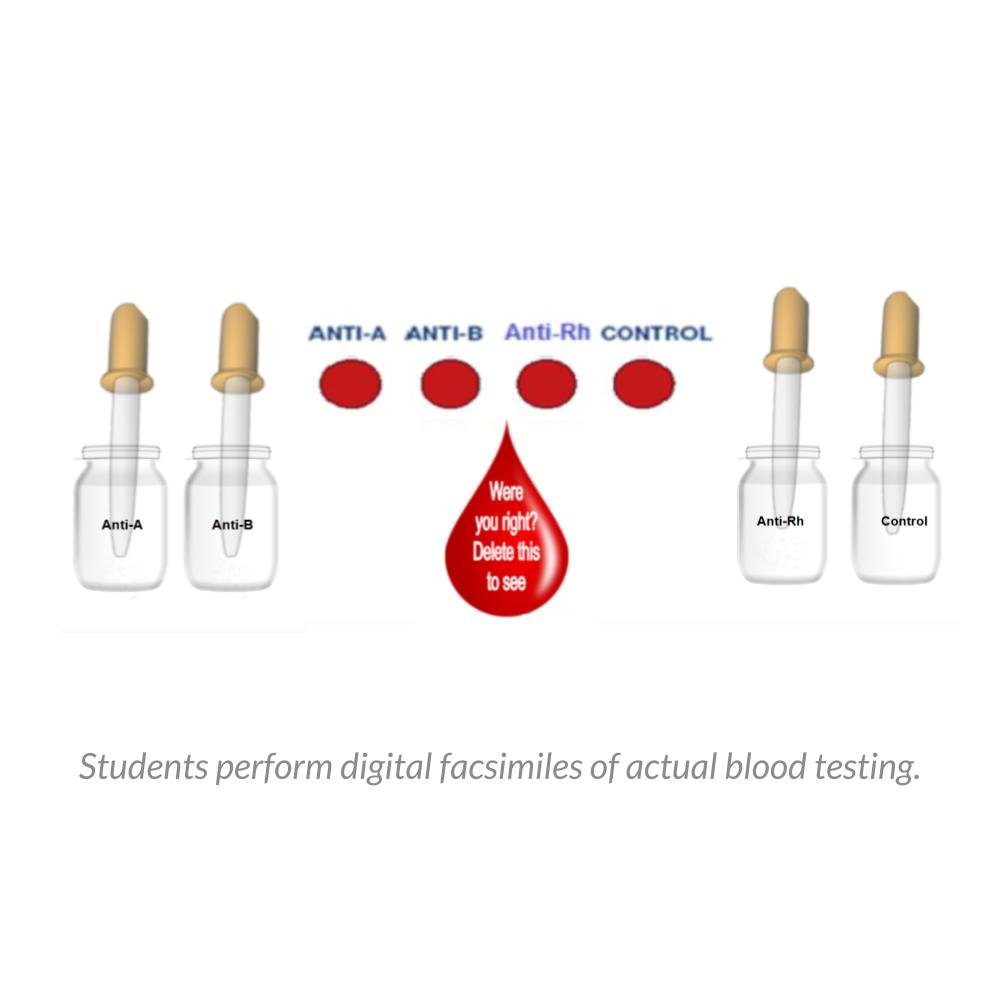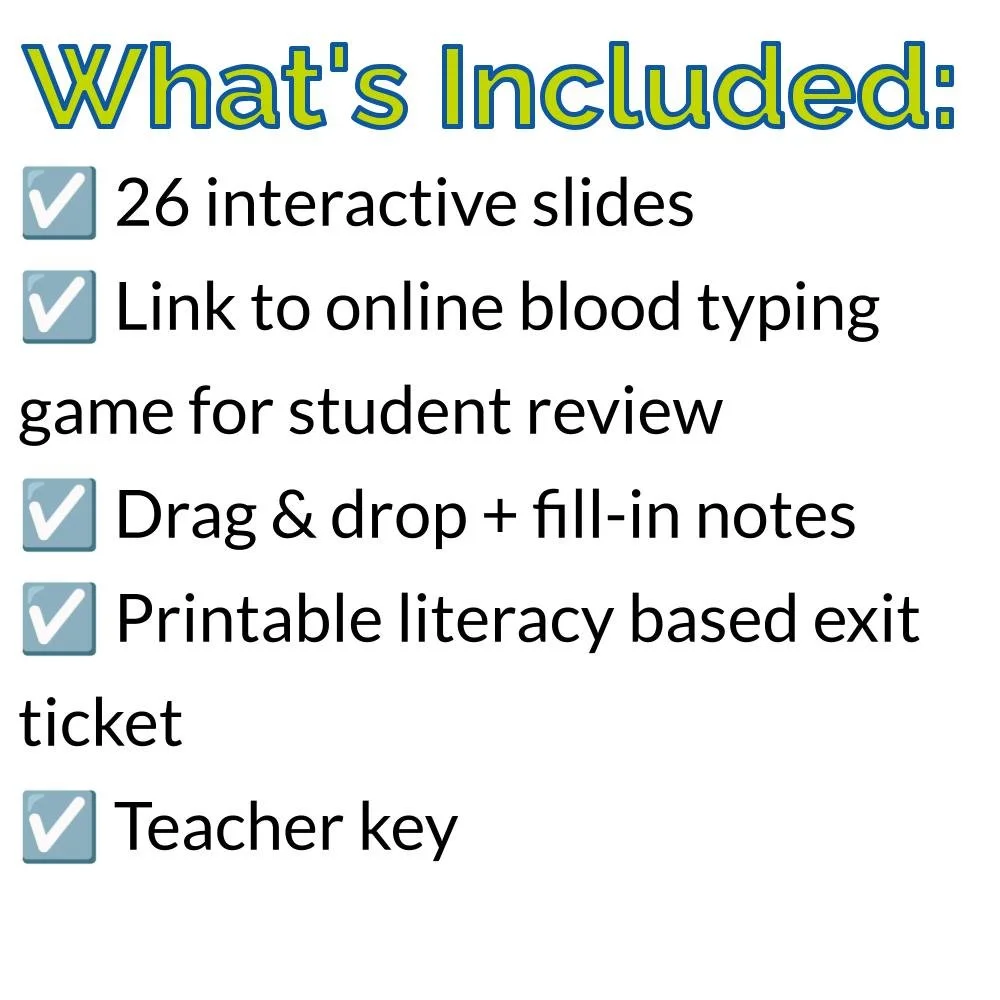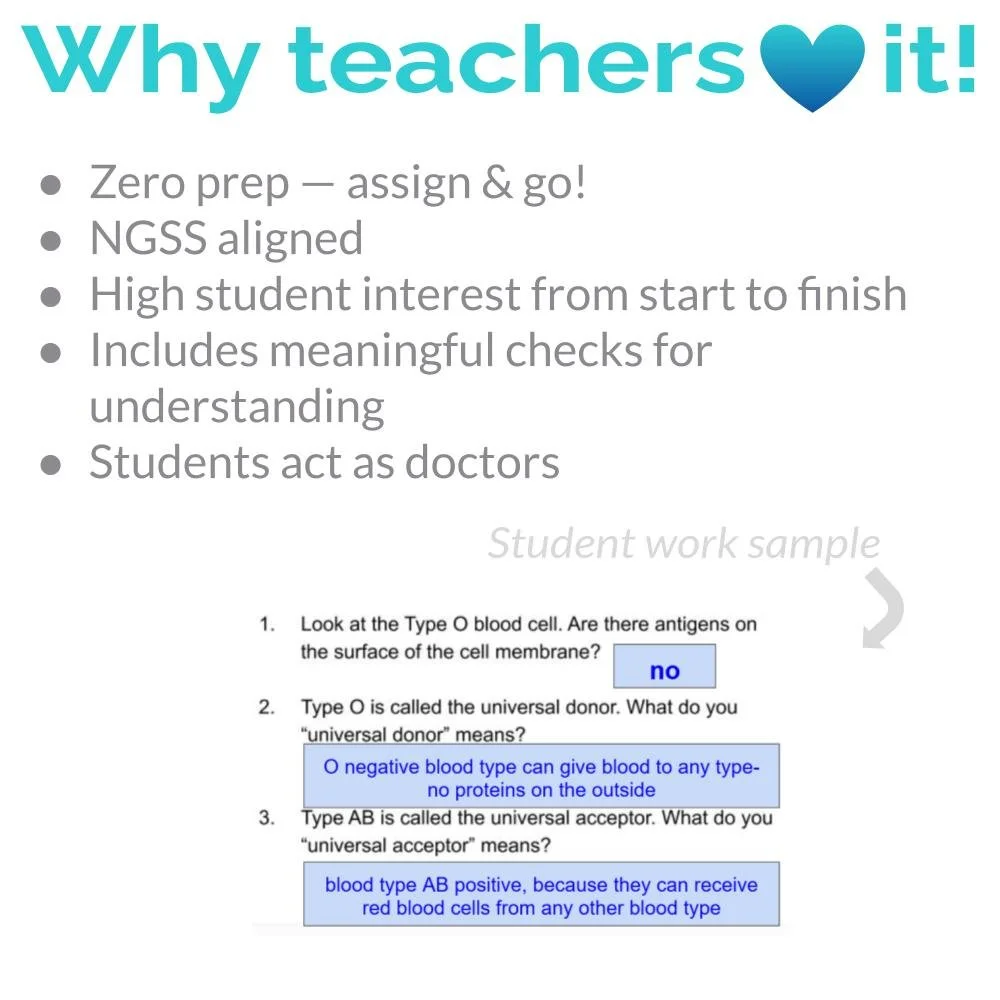



Blood Types & Blood Typing Activity | ABO & Rh Factor Interactive Digital Lesson
Students model ABO and Rh blood types through notes, virtual blood typing, and an interactive game.
Elevate Understanding: This creatively crafted remote learning-ready lesson is your gateway to unraveling the mysteries of blood types. By the end of this interactive journey, students will possess a comprehensive grasp of the science behind blood typing, from its components to its implications in medical practice.
The Roadmap to Mastery:
Blood Components: Begin by delving into the fundamental elements of blood - plasma, red blood cells, white blood cells, and platelets. Match each component to its pivotal function in the circulatory system.
ABO Antigens: Discover how the presence or absence of antigen proteins determines a person's blood type. Engage with a hands-on activity where students apply their knowledge by placing antigens on blank red blood cells, solidifying their understanding of ABO blood types.
Universal Donors and Receivers: Navigate the distinctions between ABO blood types to identify the universal donor and receiver, crucial knowledge in medical emergencies.
Global Insights: Immerse yourself in a short video that offers a panoramic view of the science, history, and global distribution of blood types, enriching your understanding of this fascinating topic.
➕➖ Rh Factor Revelation: Dive into the realm of Rh+ and Rh- blood types. Cement your understanding by placing antigens on blank red blood cells, reinforcing your knowledge of this vital aspect of blood typing.
Reading Blood Type Results: Learn the art of interpreting blood type testing results, a skill that forms the cornerstone of medical diagnostics.
Digital Blood Typing: Perform virtual blood typing tests using clipart pipettes and blood sample images. Confirm your results using the provided key, and deepen your comprehension by applying antigens to blank red blood cells.
US Blood Type Demographics: Analyze a pie chart to gain insights into the distribution of specific blood types within the United States, offering a real-world perspective on this critical medical field.
↔️ Blood Compatibility: Determine which blood types can safely donate to one another, reinforcing your understanding with visual aids.
Nobel Prize Blood Typing Game: Conclude your educational odyssey with an engaging game available on the Nobel Prize website, applying your newfound knowledge in a fun and interactive way.
Empower Your Learning: This lesson transcends theory, providing students with a deep and practical understanding of blood types, empowering them in medical contexts and beyond.
Begin Your Blood Typing Expedition: Elevate your understanding of blood types and their implications. Embrace this opportunity to become a master of this critical aspect of medical science.
To preview this product, click here.
Grade & Course Recommendation:
Middle School: Grade 8 advanced life science, if introducing codominance or antigen concepts.
High School: Standard Grade 9–10 biology genetics unit, especially during inheritance or immunity topics.
Cross-Curricular Connections:
Math Integration: Students calculate genotypic and phenotypic ratios.
Health & Medicine Integration: Links to transfusion compatibility and human physiology.
Extension Idea: Research blood type prevalence across populations or regions.
Although this lesson is part of the Human Body Basics Series, it works especially well for Grades 8–10 due to the logical reasoning involved in determining blood types.
Daily slide + literacy - based exit ticket included with purchase
Join the Lesson Laboratory and Teach for Tomorrow!
NGSS (Next Generation Science Standards)
HS-LS1-2: Develop and use a model to illustrate the hierarchical organization of interacting systems that provide specific functions within multicellular organisms. (connection: blood as a system of cells with specialized functions—red blood cells, white blood cells, platelets, plasma)
HS-LS1-3: Plan and conduct an investigation to provide evidence that feedback mechanisms maintain homeostasis. (connection: blood compatibility, immune response, transfusion reactions)
Science & Engineering Practices: Developing and using models; Planning and carrying out investigations; Asking questions and defining problems.
Crosscutting Concepts: Structure and function; Cause and effect; Systems and system models.
Common Core Alignment
CCSS.ELA-LITERACY.RST.9-10.4 / RST.11-12.4: Determine the meaning of domain-specific terms (antigen, antibody, Rh factor).
CCSS.ELA-LITERACY.RST.9-10.7 / RST.11-12.7: Integrate quantitative information (blood compatibility charts) with written explanations.
CCSS.ELA-LITERACY.WHST.9-12.2: Write explanatory texts that describe inheritance and immune response in blood typing.
Students model ABO and Rh blood types through notes, virtual blood typing, and an interactive game.
Elevate Understanding: This creatively crafted remote learning-ready lesson is your gateway to unraveling the mysteries of blood types. By the end of this interactive journey, students will possess a comprehensive grasp of the science behind blood typing, from its components to its implications in medical practice.
The Roadmap to Mastery:
Blood Components: Begin by delving into the fundamental elements of blood - plasma, red blood cells, white blood cells, and platelets. Match each component to its pivotal function in the circulatory system.
ABO Antigens: Discover how the presence or absence of antigen proteins determines a person's blood type. Engage with a hands-on activity where students apply their knowledge by placing antigens on blank red blood cells, solidifying their understanding of ABO blood types.
Universal Donors and Receivers: Navigate the distinctions between ABO blood types to identify the universal donor and receiver, crucial knowledge in medical emergencies.
Global Insights: Immerse yourself in a short video that offers a panoramic view of the science, history, and global distribution of blood types, enriching your understanding of this fascinating topic.
➕➖ Rh Factor Revelation: Dive into the realm of Rh+ and Rh- blood types. Cement your understanding by placing antigens on blank red blood cells, reinforcing your knowledge of this vital aspect of blood typing.
Reading Blood Type Results: Learn the art of interpreting blood type testing results, a skill that forms the cornerstone of medical diagnostics.
Digital Blood Typing: Perform virtual blood typing tests using clipart pipettes and blood sample images. Confirm your results using the provided key, and deepen your comprehension by applying antigens to blank red blood cells.
US Blood Type Demographics: Analyze a pie chart to gain insights into the distribution of specific blood types within the United States, offering a real-world perspective on this critical medical field.
↔️ Blood Compatibility: Determine which blood types can safely donate to one another, reinforcing your understanding with visual aids.
Nobel Prize Blood Typing Game: Conclude your educational odyssey with an engaging game available on the Nobel Prize website, applying your newfound knowledge in a fun and interactive way.
Empower Your Learning: This lesson transcends theory, providing students with a deep and practical understanding of blood types, empowering them in medical contexts and beyond.
Begin Your Blood Typing Expedition: Elevate your understanding of blood types and their implications. Embrace this opportunity to become a master of this critical aspect of medical science.
To preview this product, click here.
Grade & Course Recommendation:
Middle School: Grade 8 advanced life science, if introducing codominance or antigen concepts.
High School: Standard Grade 9–10 biology genetics unit, especially during inheritance or immunity topics.
Cross-Curricular Connections:
Math Integration: Students calculate genotypic and phenotypic ratios.
Health & Medicine Integration: Links to transfusion compatibility and human physiology.
Extension Idea: Research blood type prevalence across populations or regions.
Although this lesson is part of the Human Body Basics Series, it works especially well for Grades 8–10 due to the logical reasoning involved in determining blood types.
Daily slide + literacy - based exit ticket included with purchase
Join the Lesson Laboratory and Teach for Tomorrow!
NGSS (Next Generation Science Standards)
HS-LS1-2: Develop and use a model to illustrate the hierarchical organization of interacting systems that provide specific functions within multicellular organisms. (connection: blood as a system of cells with specialized functions—red blood cells, white blood cells, platelets, plasma)
HS-LS1-3: Plan and conduct an investigation to provide evidence that feedback mechanisms maintain homeostasis. (connection: blood compatibility, immune response, transfusion reactions)
Science & Engineering Practices: Developing and using models; Planning and carrying out investigations; Asking questions and defining problems.
Crosscutting Concepts: Structure and function; Cause and effect; Systems and system models.
Common Core Alignment
CCSS.ELA-LITERACY.RST.9-10.4 / RST.11-12.4: Determine the meaning of domain-specific terms (antigen, antibody, Rh factor).
CCSS.ELA-LITERACY.RST.9-10.7 / RST.11-12.7: Integrate quantitative information (blood compatibility charts) with written explanations.
CCSS.ELA-LITERACY.WHST.9-12.2: Write explanatory texts that describe inheritance and immune response in blood typing.